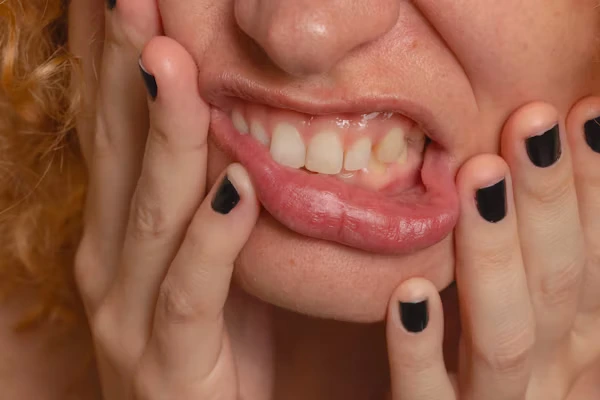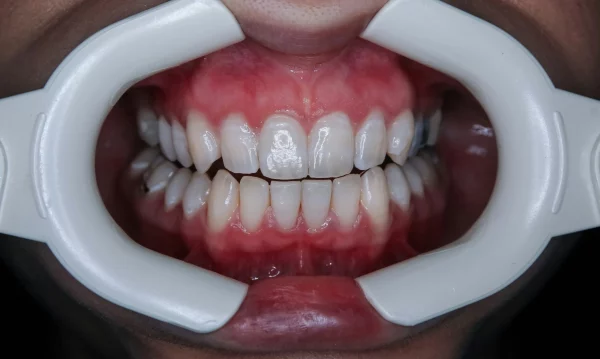After orthodontic treatment, the removal of braces often reveals not just improved alignment but also unexpected discoloration or uneven staining on the teeth. This phenomenon is quite common, brackets and wires can make it difficult to maintain optimal oral hygiene, resulting in areas of dullness or persistent stains where plaque and food debris become trapped.
Teeth whitening procedures, when conducted thoughtfully and with attention to enamel safety, offer an effective solution for restoring a uniform, healthy appearance to the smile. By addressing color inconsistencies across all teeth, whitening enhances both the aesthetic outcome and the individual’s self-confidence following orthodontic care. A properly executed teeth whitening regimen can be the final step that truly completes the smile transformation.
Teeth Whitening After Braces: Why It’s Often Necessary

After orthodontic treatment, once braces are removed, it’s quite common for patients to notice uneven tooth coloration or residual stains, especially in areas that were difficult to clean during treatment. These discolorations typically result from plaque buildup around brackets. Teeth whitening procedure can play a significant role at this stage, helping to create a more uniform and aesthetically pleasing appearance by evening out the color of the enamel. With careful attention to safety, protecting the enamel and gingival tissues, individuals can achieve a visibly brighter, cleaner smile that complements the alignment achieved through orthodontics. Ultimately, teeth whitening after braces not only enhances dental aesthetics but also contributes to a sense of confidence and satisfaction with one’s smile.
Staining That Occurs During Orthodontic Treatment
Braces, by their very design, tend to trap food debris, pigments, and plaque in the numerous small spaces they create. Even with diligent oral hygiene practices, such as thorough brushing and flossing, the brackets themselves present barriers that impede complete cleaning of the enamel surface. As a result, these areas are more susceptible to discoloration or staining over time. Once orthodontic treatment concludes and the adhesive is removed, it is common to observe that the enamel beneath the brackets remains lighter compared to the surrounding surfaces, which may appear darker or more yellow.
This contrast can produce a patchy or checkerboard appearance on the teeth. Fortunately, professional teeth whitening procedures can effectively address this unevenness, helping to restore a more uniform and aesthetically pleasing tooth color.
Why Teeth Whitening Should Wait Until Braces Are Removed
For effective whitening, the product must make consistent contact with the tooth enamel. Brackets on braces interfere with this process, preventing the gel or light from reaching certain areas and resulting in uneven whitening. Additionally, bleaching agents can compromise the integrity of the adhesive used to secure the brackets, which may make their removal more difficult. Therefore, it is advisable to postpone teeth whitening treatments until after orthodontic appliances have been removed.
Common Concerns About Tooth Sensitivity Post‑Braces
Following the removal of orthodontic appliances, it’s entirely expected for patients to experience some degree of dental tenderness, likely attributable to slight enamel abrasion or gingival irritation. Initiating an intensive bleaching regimen immediately afterward can exacerbate this sensitivity. Allowing a brief recovery period—typically one to two weeks—proves beneficial. During this interval, natural remineralization occurs, aided by saliva, and soft tissue irritation tends to subside. This waiting period also diminishes the likelihood of acute sensitivity episodes (commonly referred to as “zingers”) associated with teeth whitening procedures. Exercising patience here facilitates a more comfortable and successful whitening outcome.
Best Teeth Whitening Methods After Braces
Following orthodontic treatment, patients often notice uneven coloration or patchiness on their teeth. Teeth whitening procedures can help restore a more uniform and aesthetically pleasing smile. For individuals seeking rapid and significant results, in-office whitening treatments are highly effective, particularly for addressing deeper stains. Alternatively, custom take-home trays provided by a dental professional offer a slower, more controlled approach, minimizing the risk of sensitivity and allowing patients to manage their whitening progress. Over-the-counter products, such as whitening strips, may offer convenience; however, their effectiveness on uneven tones or areas previously covered by brackets is typically limited.
For patients experiencing sensitivity post-braces, it is advisable to wait one to two weeks before initiating any teeth whitening regimen and to select products with lower concentrations of peroxide to reduce discomfort. In cases where discoloration persists, dental practitioners may recommend additional interventions, such as enamel polishing or micro abrasion, to further smooth and harmonize tooth color. Ultimately, consulting with a dental provider is essential to determine the safest and most appropriate whitening strategy tailored to individual needs.
Professional Teeth Whitening vs. At‑Home Kits
In-office teeth whitening procedures employ a highly concentrated peroxide solution, frequently enhanced with LED or laser light to accelerate the whitening process. Typically, patients observe significant improvement in tooth color following a single one-hour session. For individuals seeking a more flexible approach, custom take-home trays provided by a dental professional represent an effective alternative. These trays are tailored to the patient’s mouth and used in conjunction with professional-grade teeth whitening gel over a period of 10 to 14 days.
Conversely, over-the-counter products such as whitening strips or brush-on pens are more accessible and cost-effective. However, these options contain lower concentrations of peroxide, which generally leads to slower and potentially less uniform results compared to professional treatments.
Are Whitening Strips Safe Right After Braces?
It is generally considered safe to pursue teeth whitening after the removal of braces, provided that the gums have adequately healed and any residual bonding resin has been properly polished away. While over-the-counter whitening strips are a common option and can conform to the shape of the teeth, they may fail to reach areas near the gumline or between teeth, potentially resulting in uneven whitening, particularly if there is existing discoloration post-braces. For more uniform results, custom whitening trays provided by a dental professional are typically recommended. These trays offer more consistent coverage and can help minimize sensitivity, leading to a more balanced and aesthetically pleasing outcome.
Laser Teeth Whitening for Fast Results
“Laser” whitening, though, to be precise, it’s typically LED-accelerated whitening, works by hastening the breakdown of peroxide, which results in stains being lifted more efficiently. This approach is especially popular among individuals preparing for significant events such as weddings or reunions, given its ability to deliver visibly brighter teeth in just one session. The trade-off for these rapid results is a higher cost compared to standard teeth whitening methods and a greater likelihood of temporary tooth sensitivity. To address this, dental professionals commonly apply a desensitizing gel before or after the procedure, reducing potential discomfort for patients.
Teeth Whitening for Sensitive Teeth Post‑Braces
Teeth whitening following the removal of braces is certainly feasible, even for individuals experiencing heightened sensitivity, provided that a cautious, well-informed approach is taken. It is advisable to wait approximately one to two weeks post-debonding, allowing the enamel and gingival tissues sufficient time to recuperate. During this recovery period, natural remineralization processes facilitated by saliva help restore tooth integrity and reduce inflammation.
When considering teeth whitening, opt for products specifically formulated for sensitive teeth. These typically contain lower concentrations of peroxide or incorporate desensitizing agents such as fluoride or potassium nitrate. Custom-fitted trays, provided by dental professionals, are preferable, as they ensure uniform application and minimize the risk of gingival irritation.
It is also beneficial to use a desensitizing toothpaste both prior to and following whitening procedures, as this can further alleviate discomfort. Ultimately, consulting with a dental provider before initiating any whitening regimen is essential in order to select the safest and most effective option for your specific dental situation.
Products Formulated for Sensitive Smiles
A lower concentration of carbamide peroxide, think around 10%, serves as a milder approach to teeth whitening, offering gradual improvements with minimal risk of irritation. This method is particularly suitable for individuals with heightened tooth sensitivity or those who have recently had their braces removed. Additionally, many teeth whitening gels are formulated with potassium nitrate or fluoride, both of which contribute to nerve desensitization and enamel fortification throughout the whitening process. This thoughtful combination promotes a more comfortable teeth whitening experience, enabling effective results while prioritizing oral health and minimizing discomfort.
Gradual Whitening vs. One‑Time Treatments
Spacing out whitening treatments over two or even three weeks actually allows your enamel some recovery time between sessions—definitely a smart move. Sure, you might not see results as instantly as you would with those in-office procedures, but honestly, the final outcome? Often just as impressive, maybe even better in some cases. This slower pace is also way kinder to your teeth, cutting down on that brutal, sharp sensitivity people sometimes get from more intense bleaching. So really, it’s a much gentler, more comfortable approach for achieving a brighter, more even smile. Plus, the gradual improvement looks a lot more natural—nobody’s going to accuse you of swapping in a set of movie-prop teeth overnight.
How to Minimize Sensitivity While Whitening
To minimize discomfort during the teeth whitening process, it’s advisable to begin with a soft-bristled toothbrush and a low-abrasion toothpaste to protect enamel. Prior to applying any bleaching agents, using a fluoride rinse or gel for about 10–15 minutes can help fortify the enamel and decrease sensitivity. Should you experience sudden or sharp sensations, it’s best to pause whitening treatments for a day or two to allow the enamel to rehydrate. Additionally, avoiding foods and beverages that are excessively hot or cold during this period can prevent further irritation. Instead, opt for lukewarm options, which are less likely to aggravate sensitive nerves. These simple adjustments can significantly increase comfort while still enabling effective whitening results.
Cost of Teeth Whitening After Braces
Life isn’t some fixed destination you simply arrive at, it’s more akin to an ongoing expedition, unpredictable and often without a clear itinerary. Progress happens in increments, sometimes barely noticeable, yet each small advancement contributes to personal development. Adversity, rather than convenience, is what shapes one’s character. Triumphs, no matter their scale, serve as significant markers along the way, providing motivation and a sense of accomplishment.
Through accumulated experiences, both successful and challenging, individuals acquire greater wisdom, resilience, and adaptability. The process is ongoing; there’s no definitive endpoint, just continual opportunities for growth and self-improvement. Furthermore, the journey doesn’t occur in isolation. The determination and perseverance demonstrated can influence others, encouraging them to embark on their own paths and fostering a broader culture of positive change. Ultimately, one’s journey becomes a testament to the enduring value of perseverance and the transformative nature of personal growth.
How Much Is Professional Whitening After Orthodontics?
Chairside whitening services in Frederick and Gaithersburg generally range from $450 to $700 per appointment. Several variables influence this pricing, including the specific whitening gel selected, the type of LED or laser technology utilized, and the possible application of a desensitizing varnish to minimize post-procedure sensitivity. Some dental clinics may also offer take-home trays or follow-up care as part of the overall package. Although this method is notably more expensive compared to at-home whitening alternatives, it provides significantly faster and more visible results, often in a single session. For individuals preparing for important events, the efficiency and effectiveness of chairside whitening frequently justify the higher cost.
Teeth Whitening Kit Prices vs. In‑Office Treatments
Custom whitening trays provided by dental professionals generally range from $200 to $400 for both upper and lower arches, and the initial cost typically includes a starting supply of whitening gel. These trays are fabricated to fit the unique contours of the patient’s dentition, which enables more uniform gel application and can lead to improved results, this is particularly advantageous for individuals who have recently completed orthodontic treatment with braces.
On the other hand, over-the-counter whitening strips are markedly less expensive, usually priced between $30 and $60 per box. While this makes them more accessible, these strips may not conform perfectly to all tooth surfaces, especially in areas previously covered by orthodontic brackets. As a result, multiple boxes may be necessary to achieve a consistent whitening effect across all teeth.
Although whitening strips offer a lower upfront cost, custom trays tend to yield more reliable and longer-lasting outcomes due to their tailored fit and comprehensive coverage. Ultimately, the decision between these options depends on the user’s priorities regarding cost, convenience, and desired results.
Using HSA/FSA for Post‑Braces Whitening
Generally speaking, dental insurance doesn’t cover cosmetic treatments like teeth whitening. That said, certain Flexible Spending Accounts (FSAs) or Health Savings Accounts (HSAs) might make an exception if whitening is deemed necessary following orthodontic treatment. You’ll want to contact your plan administrator directly for confirmation, don’t just rely on guesswork. Should it be allowed, request a detailed, itemized receipt from your dental provider that explicitly connects the whitening procedure to your recent braces removal. Accurate documentation is crucial here; without it, reimbursement is unlikely, and you could end up bearing the full cost yourself.
Teeth Whitening Near Me: Choosing the Right Provider
When you search for “teeth whitening near me,” you’re likely to encounter an overwhelming number of providers, but they’re not all created equal. It’s tempting to pick the most convenient or cheapest option, but that doesn’t always guarantee safety or results. Instead, prioritize dental professionals with a proven track record in cosmetic procedures who utilize reputable, ADA-approved whitening products. It’s also worth asking whether they offer both in-office and take-home treatments, especially if you have sensitive teeth or have recently had your braces removed.
Reading patient reviews and inquiring about anticipated outcomes, potential risks, and follow-up care can help you make a confident decision. Ultimately, the most qualified providers will tailor their approach to your specific needs, aiming to deliver a whiter, healthier-looking smile with minimal discomfort.
Why G&P Dental Is Trusted for Cosmetic Aftercare
At our practice, we reject a generic approach to teeth whitening. Instead, our clinicians conduct a thorough review of your dental history, including prior orthodontic work and enamel condition, with particular attention to factors like sensitivity. We document your initial tooth shade and engage in a clear discussion to establish realistic expectations for your whitening outcomes.
Throughout the process, treatment is actively monitored and adjusted—gel potency is modified based on your comfort and visible progress. This ensures that care remains individualized rather than formulaic. Our methodology prioritizes both safety and efficacy, with the ultimate goal of achieving consistent, natural-looking, and enduring results.
What to Expect During a Whitening Consultation
A standard teeth whitening appointment typically begins with a brief oral examination to assess the health of your enamel and identify any sensitive areas. The clinician will determine your current tooth shade usually by comparing to a shade guide and discuss your desired outcome, which is especially relevant if you plan to receive a retainer in the near future. Any residual adhesive from previous orthodontic appliances, such as braces, will be gently polished away to ensure a smooth and clean tooth surface.
For individuals prone to sensitivity, a desensitizing agent can be applied prior to the whitening procedure. The provider will also outline the procedural timeline, review associated costs, and help set realistic expectations tailored to your individual case. The overarching objective is to achieve a safe and effective whitening result that enhances your confidence and comfort.
Custom Whitening Plans for Post‑Braces Patients
Some individuals opt to begin their whitening process in a clinical setting, seeking rapid and noticeable improvements, before transitioning to custom-fitted trays at home for more precise adjustments. Others may favor the gradual progression afforded by at-home trays alone, allowing for more controlled changes over time. For patients prone to sensitivity, a more conservative regimen such as alternating between fluoride treatments and low-concentration whitening agents can protect enamel while still achieving incremental results. Treatment plans are highly individualized; there is no universal approach. Ultimately, the objective remains consistent: to achieve a uniform, natural-looking brightness that harmonizes with the patient’s complexion and enhances their overall appearance.
Frequently Asked Questions (FAQs)
1. When can I start whitening my teeth after braces?
Most dentists recommend waiting about one to two weeks after your braces are removed before starting any whitening treatment. This short pause allows your gums to heal and gives your enamel time to rehydrate. Rehydrated enamel is less sensitive and more responsive to bleaching gel, leading to more even, comfortable results. If you had attachments from clear aligners, those areas also need to be polished smooth before whitening begins. Starting too soon can lead to blotchy spots, increased sensitivity, and overall less effective results. Giving your smile time to recover sets the stage for a safer and more successful whitening experience.
2. Is it normal to have uneven color after braces removal?
Yes, it’s common to notice uneven tooth color after braces come off. Areas once covered by brackets often appear lighter because they were protected from everyday staining agents like coffee, tea, or pasta sauce. Meanwhile, the exposed enamel may have gradually darkened during treatment. While professional polishing can remove surface residue, achieving a uniform shade typically requires whitening. The good news? That patchy, checkerboard look blends out quickly with the right whitening approach tailored to your needs.
3. What’s the safest method for whitening sensitive teeth?
A custom tray with low-concentration carbamide peroxide (10%–16%) offers a gentle yet effective whitening solution, especially for sensitive teeth. Wearing the tray for shorter sessions about two hours every other day can help minimize discomfort. Pairing the treatment with a fluoride or potassium-nitrate toothpaste helps soothe nerve endings and protect enamel. It’s also wise to avoid very acidic foods and drinks during the whitening period, as they can increase sensitivity. If you experience sharp “zingers,” take a 48-hour break and resume whitening on a reduced schedule. This careful approach balances comfort with visible, gradual results.
4. Can I use over‑the‑counter whitening products after braces?
You can use over-the-counter whitening products after braces, but it’s important to manage expectations. Whitening strips may not fully reach areas where brackets were, which can leave behind slight banding or uneven shades. One-size-fits-all trays with gel can also leak, causing gum irritation or discomfort. If budget is a concern, starting with pharmacy strips is fine just consider finishing with a dentist-supervised kit to even out your final results. Always read the product instructions carefully, and stop use if your gums become white, sore, or irritated. A cautious approach helps protect your smile while still brightening effectively.
5. How long does it take to see results?
In-office laser whitening can brighten your teeth by several shades in just one visit, with results visible right away. Custom take-home trays typically take 10 to 14 days to reach their full effect, offering a more gradual change. Over-the-counter kits often require consistent use for three to six weeks to see noticeable results. It’s also important to note that enamel continues to rehydrate for about 48 hours after bleaching. This means the final, true color of your teeth won’t fully settle until a couple of days after your last whitening session. Patience during this window helps you better assess your results.
Your braces already did the hard work of aligning your teeth; now let us help them shine. Graham Park Dental offers tailored whitening solutions designed specifically for post‑braces smiles, balancing brilliance with sensitivity care. Ready to see your smile’s full potential? Call us or book a no‑pressure consultation online. A brighter, more even smile is just one visit away.


